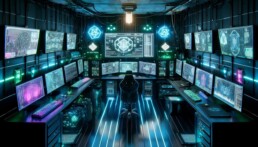IP rights: what happens when you purchase an NFT?
As NFTs (Non-Fungible Tokens) continue to redefine digital ownership, a major conversation is emerging around intellectual property (IP) rights and licensing. While NFTs offer creators exciting new ways to monetize their work, the legal structures surrounding who owns what and what rights come with an NFT purchase are still evolving.
What Does Buying an NFT Actually Mean?
When someone buys an NFT, they’re purchasing a unique token on the blockchain that is linked to a digital asset—like an artwork, music track, video, or even a virtual item. However, owning an NFT does not automatically grant full intellectual property rights to the underlying content. Unless explicitly stated, buyers typically acquire the right to possess, display, or resell the token, but not the copyright or commercial usage rights of the content it represents.
This is where IP licensing comes into play. Creators can attach smart contracts or terms of use to their NFTs to define what rights are transferred with the token. These licenses can vary widely:
-
Personal Use Licenses: Buyers can display or share the content for non-commercial purposes.
-
Commercial Use Licenses: Buyers are allowed to monetize the content—print it on merchandise, use it in branding, etc.
-
Creative Commons or Open Licenses: Some creators choose to make their content open-source, allowing broad reuse and remixing.
Without clear licensing, there can be legal ambiguity about what buyers can and cannot do with the NFT they own.
This creates new opportunities for artists and creators. IP licensing gives them more control and flexibility in how their work is used. So this enables them to work on specific rules for usage, uutomate royalty payments on resales via smart contracts, and offer tiered licenses based on token ownership.
It creates new business models that go beyond the traditional gallery or publisher route—empowering creators to monetize directly and transparently.
All about rights and royalties
One of the big revolutions that NFTs and blockchain bring to the table for artists and creatives is ownership. This new technology transforms the way creatives are actually going to define this concept.
In the context of the NFT (Non-Fungible Token) space, rights and royalties refer to the ownership and compensation structure for creators and original content owners when their NFTs are sold or transferred in secondary markets. Here's how they work:
- Rights: When a creator mints an NFT, they retain certain rights associated with the original content. These rights might include the right to reproduce, distribute, display, and perform the content. Depending on the terms set by the creator, these rights can be specified for both the primary sale and any subsequent resales of the NFT.
- Royalties: Royalties in the NFT space refer to a percentage of the sale price that the original creator receives every time the NFT is sold in a secondary market. This is particularly important because, in traditional art and content markets, creators often don't benefit financially from the increased value of their work after the initial sale. With NFTs, the use of blockchain technology enables automatic royalty payments to creators every time their NFT is resold.
Here's how the process generally works:
- Minting and Primary Sale: The creator mints an NFT representing their content. When this NFT is sold for the first time (primary sale), the creator sets the initial price and the terms of the sale. This can include the percentage of royalties they want to receive from any future resales of the NFT.
- Secondary Sales: When the owner of the NFT decides to resell it on NFT marketplaces, the blockchain technology ensures that a portion of the sale goes back to the original creator as royalties. This is typically automated and transparent, as the blockchain records and enforces the terms set during the minting process.
- Smart Contracts: Smart contracts, which are self-executing contracts with the terms of the agreement directly written into code, play a crucial role in enabling automatic royalty payments. These contracts are programmed to distribute royalties according to the percentages specified by the creator.
- Marketplace Support: Not all NFT marketplaces support royalties, so it's important for creators to choose platforms that offer this feature. Marketplaces like OpenSea, Rarible, and Foundation are known to support royalties and automated payments.
Royalties and rights in the NFT space bring a new level of fairness and empowerment for creators. They enable creators to receive ongoing compensation as the value of their work appreciates in the secondary market, and they ensure that creators' interests are upheld even as NFTs change hands multiple times.
How to obtain POL?
In Web3 spaces changes occur in a fast pace. The Polygon network has changed the way to obtain POL faucet so the new way to obtain POL is as following:
- Go here: https://discord.gg/t4c8VwURCV which is the discord channel of Polygon.
- Verify your account (channel on the left).
- This takes you to an external website that you can close when done.
- Go to the pol-faucet channel that you will find in the left hand side below "support".
- Send a message including your wallet address: "faucet-amoy <wallet Address>"
- For example, this message should look like this: "faucet-amoy 0x4AF88B7524D18290..."
Once done so, it will take a little while for the POL to appear in your wallet but it will certainly do.
Please ask for help in our discord channel. We are here to help.
How to Avoid High Gas Fees When Minting NFTs
Minting Non-Fungible Tokens (NFTs) can be an exciting process, but also challenging. High gas fees can sometimes make it costly, especially on networks like Ethereum. That is mainly why in DAFNE+ Platform runs under Polygon. Nevertheless, gas fees are required to process blockchain transactions, and when network traffic is high, these fees can be very high. However, there are ways to minimize costs while still successfully minting your NFTs.
Mint During Off-Peak Hours
Gas fees fluctuate throughout the day based on network congestion. By minting during off-peak hours, you can save significantly.
Use Layer 2 Solutions
Layer 2 networks like Polygon, Optimism, and Arbitrum offer significantly lower gas fees than Ethereum’s mainnet. Many NFT platforms now support these alternatives, allowing you to mint NFTs at a fraction of the cost.
Try Lazy Minting
Platforms like OpenSea offer lazy minting, where an NFT is only minted when it is purchased. This means you don’t have to pay upfront gas fees, making it a cost-effective option for artists.
Explore Alternative Blockchains
Ethereum isn’t the only option for NFTs. Blockchains like Polygon, Tezos, or Solana, offer cheaper minting fees while maintaining security and efficiency.
Set Custom Gas Limits
When minting, you can manually set a lower gas fee. However, setting it too low may cause transaction delays or failures.
By using these strategies, you can mint NFTs without breaking the bank and maximize your earnings as an artist or collector.
What Are Gas Fees and Why Do They Matter in Blockchain?
When you interact with blockchain networks like Ethereum, Polygon, or Solana, you’ve probably noticed something called gas fees. But what exactly are gas fees, and why do they play such a crucial role in blockchain transactions?
First of all, we should understand what gas fees are. Basically, they are the transaction fees required to execute operations on a blockchain network. These fees compensate the network’s validators (or miners) for the computational power they use to process and confirm transactions. Whether you're sending cryptocurrency, minting an NFT, swapping tokens, or using a decentralized app (dApp), you need to pay gas fees to ensure your transaction is recorded on the blockchain.
How do Gas Fees Work?
Gas fees are measured in small fractions of cryptocurrency and the total fee depends on several aspects such as network demand. This means that the more people use the blockchain, gas fees increase due to high competition for transaction space. During periods of congestion, fees can become very expensive.
Another key aspect is transaction complexity, so more complex transactions like NFT minting or smart contract interactions require higher fees since they consume more computational power. The last aspect to take into account will be the blockchain type. As you may already know there are different blockchains have different fee structures. For example, Ethereum (Proof of Work) has higher fees than Polygon or Solana, which use more efficient Proof of Stake mechanisms.
Gas fees are essential for keeping blockchains secure and functional, but with the right strategies, you can minimize costs and optimize transactions in the decentralized world.
From Galleries to Blockchain: The New Age of Art Collecting
The world of art collecting is undergoing a profound transformation, thanks to the rise of NFTs (Non-Fungible Tokens) and digital art. What was once the exclusive domain of galleries, auction houses, and private collectors is now becoming accessible to a broader audience, democratizing the way we buy, sell, and experience art. At the heart of this revolution is blockchain technology, which is not only changing the way art is owned but also offering new opportunities for artists and collectors alike.
Democratizing Art Collecting Through Blockchain
Traditionally, art collecting has been a privilege reserved for a select few, often requiring significant financial resources, insider knowledge, and access to exclusive networks. However, the advent of blockchain technology is leveling the playing field, making art more accessible to everyone. Here’s how:
Global Accessibility: Blockchain and NFTs have removed geographical barriers, allowing anyone with an internet connection to participate in the art market. Whether you’re in New York or Nairobi, you can browse, buy, and collect digital art from around the world with just a few clicks.
Fractional Ownership: NFTs enable fractional ownership, meaning that multiple people can own a piece of digital art. This lowers the entry barrier for collectors, making it possible to invest in high-value art pieces without needing to purchase the entire work. It’s a game-changer for democratizing ownership.
Transparency and Security: Blockchain technology ensures transparency and security in the art market. Each NFT is uniquely identifiable and traceable on the blockchain, providing a verifiable record of ownership and provenance. This eliminates the risks of forgery and fraud, offering peace of mind to collectors.
Direct Artist-Collector Relationships: NFTs allow artists to sell their work directly to collectors, bypassing traditional intermediaries like galleries and auction houses. This direct connection not only benefits artists by providing them with a larger share of the profits but also allows collectors to engage more closely with the creators behind the art.
The Benefits for Artists
New Revenue Streams: NFTs open up new revenue streams for artists, enabling them to monetize their digital creations in ways that were previously impossible. Artists can sell their work as unique digital assets, command royalties on secondary sales, and even create limited editions, all of which provide ongoing income.
Creative Freedom: The digital nature of NFTs offers artists unparalleled creative freedom. They can experiment with different forms, styles, and mediums, and even integrate interactive elements into their work. This freedom allows artists to push the boundaries of traditional art and reach new audiences.
Global Exposure: By leveraging blockchain platforms, artists can gain global exposure without the need for gallery representation or traditional marketing. This broadens their reach and enables them to connect with collectors and fans from around the world.
The Benefits for Collectors
Accessibility and Affordability: NFTs make art collecting more accessible and affordable. Collectors can purchase digital art at various price points, making it easier to build a diverse and meaningful collection without the need for a massive budget.
Investment Potential: Digital art and NFTs offer significant investment potential. As the market for digital art continues to grow, early collectors of NFTs may see their assets appreciate in value, offering potential returns on investment.
Engagement with Artists: Collecting NFTs allows for a more personalized and engaging experience. Collectors can interact directly with artists, support their work, and even influence future creations through collaborations and feedback.
Dynamic Collections: Unlike traditional art, NFTs can be displayed in various digital environments, from virtual galleries to social media platforms. This dynamic nature allows collectors to showcase their art in innovative ways and engage with it interactively.
The future of art collecting is digital, decentralized, and democratized. NFTs and blockchain technology are breaking down barriers, making it possible for anyone to participate in the art market and own unique digital works. For artists, this represents an unprecedented opportunity to monetize their creativity and reach global audiences. For collectors, it offers a new and exciting way to invest in and engage with art. As we move forward, the fusion of art and technology will continue to redefine the landscape, creating a vibrant and inclusive ecosystem where creativity thrives and art is accessible to all.
Building a Community in the NFT Space: Why It’s Essential for Artists and Projects
In the rapidly evolving world of NFTs, building a strong community is more than just a strategy, it's a necessity. For artists and projects alike, the community is the key that drives success, fuels creativity, and ensures long-term growth. But why is community-building so crucial in the NFT space, and how to start creating one is the essence of this post.
Building a community is important and matters a lot, it is what in the end will make the project a success. The reason for this is that it gives the project the support and loyalty that it needs. This means that a dedicated community acts as the core support system. These are the people who believe in the work and share the vision of the project, and are willing to invest in in it. A strong community fosters loyalty, which is invaluable in a space where trends can change overnight.
In the other hand, in the NFT space, where digital assets are often spread through social media and online platforms, word-of-mouth is incredibly powerful. The community members become the biggest advocates, spreading the word and helping to attract new followers, buyers, and collaborators.
Another key aspect of building a community is that it can provide valuable feedback that helps refine the work and align it more closely with what the audience wants. Additionally, communities often become breeding grounds for collaboration, leading to innovative projects that push the boundaries of what's possible.
In this same line, a well-engaged community adds credibility to the project. When people see a vibrant, active community around an artist or project, it signals trust and authenticity, making it easier to attract new members and investors.
In a volatile market like NFTs, having a community provides stability. As trends come and go, a loyal community can help sustain the project through fluctuations, ensuring that the project has a long-term presence in the space. So, in summary, a community helps provide sustainability and growth.
How to Build a Community in the NFT Space
So once you have a clear image of what a community may involve and bring to your project, let's talk about how to build it.
First of all, it is neccesary to define the vision and values of the project. This is clearly defining what the project or artwork stands for and what values it wants to promote. The community will be drawn to this mission, so it’s important to communicate this clearly.
After this, the project will need to choose the right platforms. It is vital to identify where the potential community members are most active. Whether it’s Discord, Twitter, Instagram, or another platform, choose the channels that align best with the audience you would like to atract. Set up spaces where members can interact, share ideas, and connect with the project directly.
Another step would be engaging consistently with the community, which means that a regular engagement is key to keeping your community active and growing. Share updates, ask for feedback, and involve your community in the creative process. The more involved they feel, the more invested they’ll be in your success.
Besides this it is also useful to create exclusive experiences, this means to offer the community members something special, whether it’s early access to new releases, exclusive content, or members-only events. This not only rewards your loyal followers but also attracts new members eager to be part of something unique.
All these techniques help encourage collaboration. Invite members to share their ideas, collaborate on projects, or even co-create NFTs. This not only enriches the community but also leads to more dynamic and diverse outcomes.
And of course, last but not least, to listen and adapt can be vital. Your community can provide insights that help improve and innovate, ensuring that the project remains relevant and appealing.
As you may read, building a community in the NFT space is not just important, it’s essential. It provides the foundation for support, growth, and sustainability in a dynamic and often unpredictable market. For artists and project creators, a strong community is the key to unlocking long-term success, driving creativity, and making a lasting impact in the digital art world.
What advantages can we find on Web3?
The World Wide Web has experienced a huge advancement lately. From the first web, also known as "Static Web", to Web 3 that we are recently getting to experience many changes have happened. From user interaction to quality of images, for example. Now Web3, also known as the "Decentralized Web", represents the next phase of the internet’s evolution. It focuses on giving users ownership of their data, content, and digital assets through blockchain technology, while removing reliance on centralized entities.
These changes have brought a series of avdantages:
User Empowerment: Web3 gives users greater control over their online presence, from managing their data to owning digital assets and participating in decentralized communities.
Increased Privacy: Users can interact with decentralized platforms without sharing personal information, reducing the risk of data breaches and enhancing privacy.
Censorship Resistance: Decentralized networks are harder to censor because there’s no central authority controlling the content. This ensures greater freedom of expression.
Transparency and Trust: Blockchain technology offers transparency by providing a publicly accessible ledger of transactions. This transparency builds trust in the system, as all transactions and interactions are verifiable.
New Economic Opportunities: Web3 introduces new ways to earn, invest, and participate in the digital economy. From creating and trading NFTs to earning tokens for participating in decentralized platforms, users can benefit financially from their online activities.
The Role of AI in Web3: Shaping the Future of the Decentralized Internet
As the internet evolves into its next phase, known as Web3, the integration of Artificial Intelligence (AI) is playing a pivotal role in shaping this new digital landscape. Web3, often referred to as the decentralized web, promises to transform how we interact online by giving users more control, privacy, and ownership of their data. But how exactly does AI fit into this vision, and what impact will it have on the future of the internet?
What is Web3?
The digital experience is being redefined as powerful technologiues such as AI and Web3 appear in the landscape. In this sense, Web3 represents a shift from the centralized, data-driven model of Web2, where large corporations control vast amounts of user data, to a decentralized model where users have more autonomy. Built on blockchain technology, Web3 enables peer-to-peer interactions, decentralized applications (dApps), and smart contracts, all without the need for intermediaries. It’s a vision of the internet where users own their data and digital assets, and where transparency and security are paramount.
The Intersection of AI and Web3:
While Web3 focuses on decentralization and user empowerment, AI brings intelligence and automation to this new internet era and its playing a critical role in Web3. For example, to enhance user experience. AI can significantly improve the user experience in Web3 by personalizing content, recommendations, and interactions in decentralized applications. Unlike traditional systems where personalization often comes at the cost of privacy, AI in Web3 can offer tailored experiences without compromising user control over their data.
In Web3, AI can operate on decentralized networks, where AI models and data are distributed across nodes rather than being held by a central entity. This decentralization of AI ensures that no single organization has control over the intelligence generated, aligning with Web3’s ethos of user empowerment and transparency.
AI enhances the functionality of smart contracts in Web3 by enabling them to execute complex, automated decisions based on real-time data. This combination can lead to more sophisticated decentralized autonomous organizations (DAOs) that operate with minimal human intervention, driving efficiency and innovation.
One of the core promises of Web3 is enhanced privacy and security. AI can help achieve this by developing advanced encryption methods, detecting and mitigating security threats, and ensuring that user data remains private and secure within decentralized networks.
AI plays a crucial role in managing digital identities and tokenization in Web3. By leveraging AI, users can create and manage decentralized identities that are secure, verifiable, and interoperable across various dApps. AI can also help in managing and trading tokenized assets in a more efficient and intelligent manner.
As Web3 platforms grow, the challenge of moderating and curating content becomes more complex. AI can assist by automating content moderation processes in a decentralized manner, ensuring that communities remain safe and that content aligns with the values and rules set by the users themselves.
The Future of AI in Web3:
The synergy between AI and Web3 holds enormous potential for the future. As these technologies continue to develop, we can expect to see AI-driven dApps that offer unprecedented levels of personalization, security, and efficiency. Moreover, decentralized AI networks could democratize access to AI, allowing individuals and smaller organizations to leverage the power of AI without relying on big tech companies.
However, this integration also comes with challenges. Ensuring that AI operates ethically within decentralized systems, managing the vast amounts of data required for AI without compromising privacy, and developing robust security measures are all critical areas that need attention.
AI and Web3 are two of the most transformative technologies of our time, and their convergence is set to redefine the future of the internet. By combining the intelligence and automation of AI with the decentralization and user empowerment of Web3, we are moving toward a digital landscape that is more personalized, secure, and democratic. As we venture into this new era, the collaboration between AI and Web3 will play a central role in shaping the way we interact, create, and transact online.
Web3: Understanding the Next Evolution of the Internet
The internet has come a long way since its creation, and we are now on the edge of a new era known as Web3. A new concept has arisen, Web3. But let's explain what is it exactly. Web3, also known as "decentralized web," represents the third phase in the evolution of the internet. It is built on the foundation of blockchain technology and emphasizes decentralization, user control, and peer-to-peer interactions. Unlike the centralized nature of Web2, where data and power are concentrated in the hands of a few large companies, Web3 aims to give users ownership over their data, digital assets, and online identities.
The Evolution of the Web: Web1, Web2, and Web3
To understand Web3, it’s important to look back at the earlier stages of the internet:
Web1 (The Static Web):
- Timeframe: Late 1980s to early 2000s
- Characteristics: Web1 was the first iteration of the internet, characterized by static web pages. Websites were mostly read-only, offering limited interactivity. Users could browse information, but they couldn’t interact with the content or create their own.
- Experience: Passive consumption of content. Users were primarily information consumers.
Web2 (The Social Web):
- Timeframe: Early 2000s to present
- Characteristics: Web2 brought about dynamic content, interactivity, and the rise of social media platforms. Users could create, share, and interact with content across various platforms (e.g., Facebook, YouTube, Instagram). However, this era also saw the centralization of power and data in the hands of a few tech giants.
- Experience: Active participation, but within platforms owned and controlled by large companies. Users create and interact with content, but their data is often monetized by these platforms.
Web3 (The Decentralized Web):
- Timeframe: Emerging era
- Characteristics: Web3 is the next step in the internet’s evolution, emphasizing decentralization, transparency, and user empowerment. It leverages blockchain technology, smart contracts, and decentralized applications (dApps) to enable peer-to-peer interactions without the need for intermediaries. Users have greater control over their data, digital assets, and online identities.
- Experience: Users not only interact and create content but also own their data, digital assets, and the platforms they use. Web3 promotes a more equitable internet where power is distributed rather than centralized.
Web3 VS Previous Web Versions
- Decentralization vs. Centralization:
- In Web2, data and power are centralized in the hands of a few corporations. Web3, on the other hand, is decentralized, meaning no single entity controls the network. Instead, power is distributed among users through blockchain networks.
- Ownership of Data:
- In Web2, users' data is often stored on centralized servers owned by tech companies, which can use or sell it without users’ explicit consent. Web3 gives users ownership of their data, enabling them to control how and where it is used.
- Intermediaries vs. Peer-to-Peer:
- Web2 relies on intermediaries (such as social media platforms, payment processors, etc.) to facilitate interactions. Web3 enables direct peer-to-peer interactions through blockchain technology, reducing the need for intermediaries.
- Security and Privacy:
- Web3 offers enhanced security and privacy features compared to Web2. With blockchain’s immutable and transparent ledger, users can trust that their data and transactions are secure. Additionally, users can interact with decentralized applications (dApps) without revealing their personal information.
- Monetization and Value:
- In Web2, platforms typically monetize user data through ads and other means, with little direct benefit to users. Web3 enables users to monetize their own data and digital assets, often through cryptocurrencies and tokens, allowing them to benefit directly from their online activities.
Web3 represents a significant shift in how we interact with the internet. By focusing on decentralization, user ownership, and transparency, Web3 promises to create a more equitable and user-centric digital world. As we move forward, the evolution of Web3 will likely unlock new possibilities for creativity, economic empowerment, and global collaboration, making the internet a truly open and democratic space for all.









